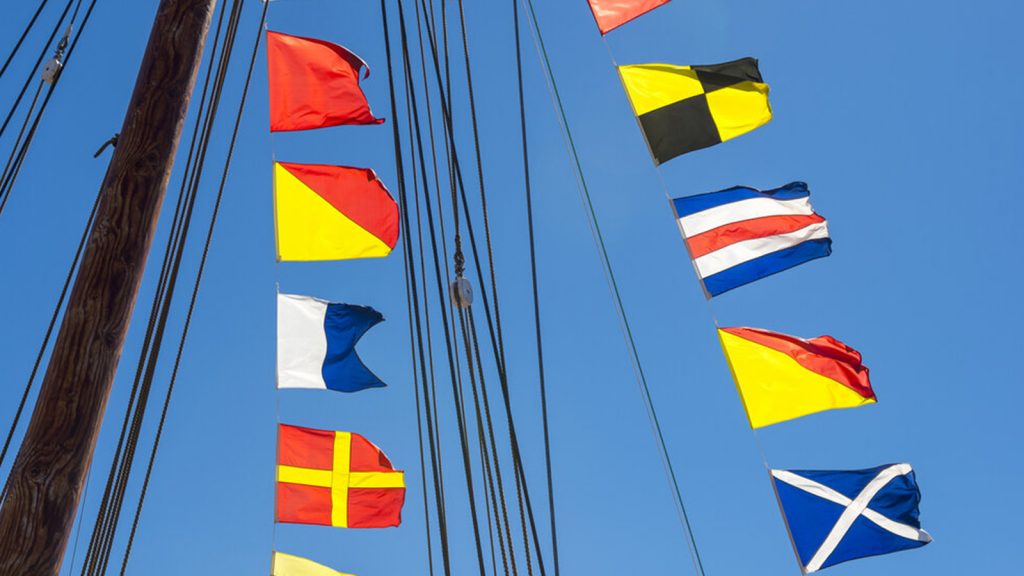Nautical flags serve the purpose of communication in situations concerning navigation safety and individuals. They form an international code system enabling boats to signal to shore or for two boats to communicate with each other.
Individual flags have specific and standard meanings. These ones can be used in combination with another flag or alone. Using different nautical colored flags have a different meaning.
What are Nautical Flags?
Nautical flags, also known as maritime signal flags, are a set of flags and pennants used to communicate messages between ships and boats. Each flag represents a specific letter, number, or message, allowing vessels to convey information even when verbal communication is not possible.
The use of nautical flags dates back centuries and continues to be an essential aspect of seafaring traditions.
Nautical flags are compose of 26 square flags that represent the letters of the alphabet. There are also 10 numbered pendants, one answering pendant and three substitutes.
You will see nautical flags in a few colors because only a few flag colors are easily recognized:
- Blue
- Yellow
- Red
- Black
- White
Nautical Flags and Their Meanings
Importance of Nautical Flag Meanings
Understanding the meanings behind nautical flags is crucial for anyone involved in maritime activities.
Whether you’re a sailor, a boater, or simply fascinated by the sea, having knowledge of nautical flag communication enables you to interpret messages, navigate safely, and respond appropriately in different situations.
International Code of Signals
The International Code of Signals, also known as ICS, is a special set of rules that tells people who use nautical flags how to use them correctly. It helps sailors understand each other and communicate important messages by using these special flags in a specific way.
It was first established in the 19th century to facilitate communication and prevent misunderstandings among ships of different nationalities.
Over time, the code evolved and expanded to cover a wide range of messages and situations encountered at sea.
Within the International Code of Signals, each nautical flag represents a specific letter or number, as well as a set of predefined messages. These flags are combined to form words, phrases, and sentences, allowing vessels to spell out messages and communicate essential information.
The nautical flags in the International Code of Signals can be categorized into several groups, including alphabetic flags, numeric pennants, substitutes, repeaters, and special flags. Each category serves a specific purpose and carries distinct meanings when used in communication.
Individual Flag Meanings
Numeric pennants and their meanings
Numeric pennants are a series of flags, each representing a number from zero to nine. These flags are used to communicate numerical information, such as coordinates, distances, or time. By combining different numeric pennants, vessels can convey precise numerical values, ensuring accurate communication between ships.
Letter flags and their meanings
Individual letters of the alphabet are represented by letter flags in the International Code of Signals. They are used to spell words and form sentences. Understanding the meanings assigned to each letter flag is critical for interpreting nautical flag messages and effectively communicating information.
Substitutes and repeaters in nautical flag communication
Substitute flags and repeater flags play important roles in nautical flag communication. Substitute flags are used to replace specific letter flags when they are not available or cannot be easily identified.
Repeater flags, on the other hand, are used to indicate that the preceding flag should be repeated. These flags ensure clarity and facilitate accurate transmission of messages.
Special flags and their purposes
The International Code of Signals includes several special flags that represent specific messages or commands. These flags convey information related to safety, medical assistance, maneuvering instructions, and more.
Understanding the meanings behind these special flags is crucial for maintaining safety and effective communication on the water.
Nautical Flags Meanings
It’s important to understand nautical flags and their meaning because they are valuable at sea in case of breakdowns in other communications systems (eg. radio) or in case of danger.
- One-flag signals are urgent or common signals.
- Two-flag signals are used for distress and maneuvering.
- Three-flag signals are for points of the compass, relative bearings, standard times, verbs, punctuation and also general code and decode signals.
- Four-flags are used mostly for geographical signals, names of ships, bearings, etc.
- Five-flag signals are used to relate time and position.
- Six-flag signals are used to indicate the main cardinal directions (N, S, E or W) in latitude and longitude signals.
- Seven-flags are used as signals for indicating longitude signals containing more than one hundred degrees.
Nautical flags are also used in nautical racing which signal to the competitors what they are supposed to do.
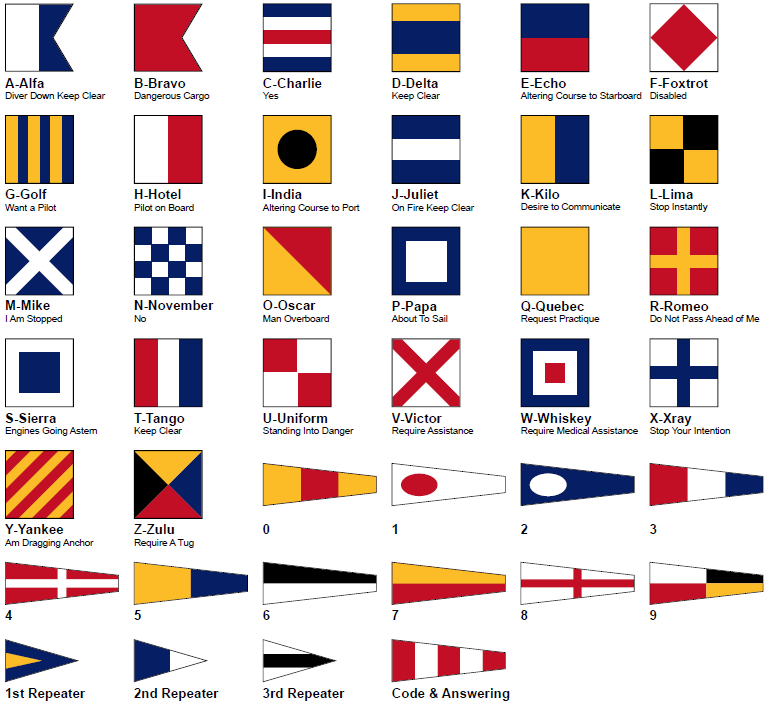
The Nautical Flag Alphabet
It is critical to understand that each flag representing a letter has a specific meaning.
International meanings for nautical flags:
- A: Alpha – diver down; I am undergoing a speed trial
- B: Bravo – carrying dangerous cargo
- C: Charlie – yes (affirmative)
- D: Delta – keep clear of me, I am manoevering with difficulty
- E: Echo – altering course to starboard
- F: Foxtrot – I am disabled, communicate with me
- G: Golf – I want a pilot
- H: Hotel – a pilot on board
- I: India – I am altering my course to port
- J: Juliet – vessel on fire keep clear
- K: Kilo – I want to communicate with you
- L: Lima – stop your vessel instantly, I have something important to communicate; Come Within Hail or Follow Me (Sailing Regatta)
- M: Mike – my vessel is stopped and making no way through the water; Mark Missing (Sailing Regatta)
- N: November – no (negative); Abandonment and Re-sail (Sailing Regatta)
- O: Oscar – Man overboard
- P: Papa – In port: All personnel return to ship; vessel is about to sail; At sea, fishing vessels might use this specific flag to convey the message “My nets have become entangled with an obstacle.”
- Q: Quebec – I request free pratique
- R: Romeo – reverse course
- S: Sierra – engines are going astern
- T: Tango – Keep clear; engaged in trawling. (International); Do not pass ahead of me. (Navy)
- U: Uniform – you are heading into danger
- V: Victor – require assistance
- W: Whiskey – require medical assistance
- X: X-ray – stop your intention
- Y: Yankee – am dragging anchor
- Z: Zulu – I require a tug
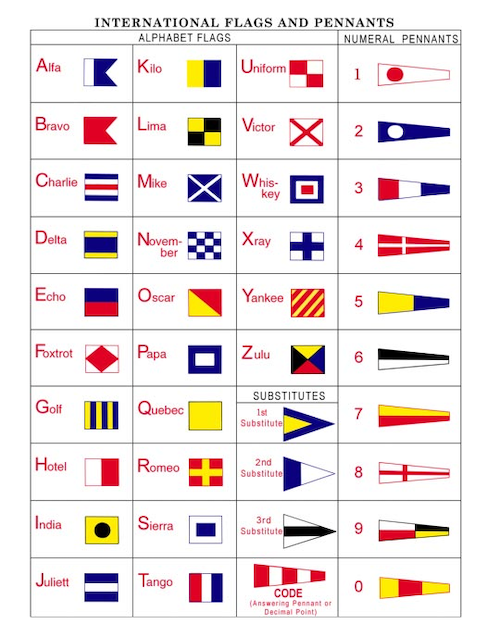
Solo or combined nautical flags have different meanings
Depending on the type of message, boats fly between 1 and 7 nautical flags. The combination of the O (Oscar) and W (Whiskey) flags, meanwhile, means “Man overboard. I require medical assistance”.
Signals with two nautical flags usually mean a certain problem of danger or maneuver. Three or more flags may include pendants and may indicate things such as compass points, time and position, geographic signals, geographic coordinates, and boat names.
Nautical Flags, sometimes the secret language of ships
While sailors around the world use nautical flags to communicate different scenarios, certain situations use secret language.
For example, the US Navy groups signals together in ways known only to its staff to communicate with its fellow ships.
NATO uses also the same nautical flags, with a few additional ones to warships, alone or in short sets to communicate various unclassified messages.
In yacht racing, the nautical flags have other meanings. These ones are solo or combined.
The P flag, for example, is employed as the “preparatory” flag to indicate an impending start, while the S flag indicates that a course has been shortened.
Nautical Flags to Buy
Interested in buying nautical flags to decorate your yacht? Whether you want to add a nautical flag pole, or you’re looking to replace an old nautical flag, we hope you find what you’re looking for!
Set of 50 Nautical Flags
We recommend this set of 50 (100% cotton) nautical flags. All flags are hand-made, so they can be quite smaller or bigger. Each flag is about 8 inches tall and 13 inches wide. All are printed on both sides. They give you a guarantee on color for life.
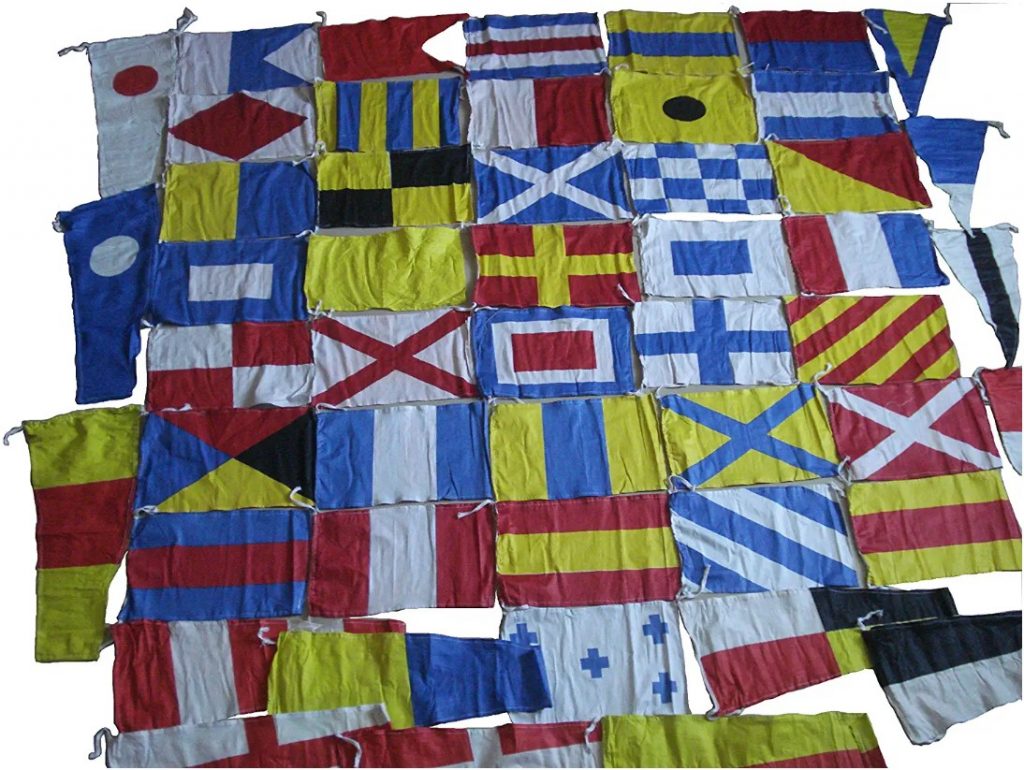
Maritime Signal Flags - 40 Different Decorative Flags - Over 40 Feet Long - Easy to Display
The flags are constructed of weather-resistant nylon cloth with double stitched seams. They are connected on a nylon chain with knots at both ends for convenient hanging.
These rectangular flags are 6″ x 9″, while pennant flags measure 6″ x 14″ or 6″ x 9″. The nylon cable is more than 40 feet long, with 7″ between flags and 36″ ties on either end.
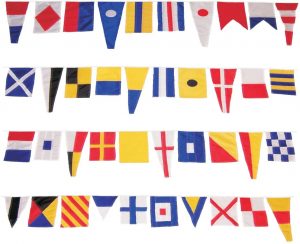
FLAGLINK International Marine Navy Signal Code Flag Set - String of 40 Flag - 40 Feet Long – Nautical Maritime Boat Ship Vessel Nautical Theme Decoration for Patry
Do you plan on throwing a big party on the boat and want to deck out the entire vessel in honor of the occasion? These nautical flags, which are less expensive than the previous ones, are an excellent choice for interior or outdoor decorations.
You may hang your ornamental flags in your front yard, garden, or patio, so that your family and friends can view the gorgeous holiday flag design from every aspect and vantage point.
Because they are constructed of a water-resistant polyester fabric, they may be left outside for an extended period of time.
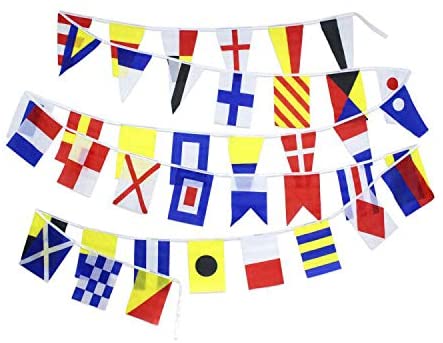
F.A.Q.
What nautical flags mean?
The purpose of nautical flags is to give ways and means of communication in circumstances involving the safety of navigation and people. Nautical flags are an international coding system used for a boat to indicate to land or for two vessels to signal to each other in situations involving the safety of navigation and people.
How many nautical flags are there?
There are 26 square nautical flags. Each of them symbolizes an international code term associated with the letters of the alphabet, such as Alpha, Bravo, Charlie, Delta, and so on.
What are nautical flags called?
Nautical flags are also known as international maritime signal flags, signal flags or boat flags.
How do you spell out messages using nautical flags?
Messages are spelled out using nautical flags by hoisting the flags in the correct sequence according to the International Code of Signals. Each flag represents a letter, and the combination of flags creates words, phrases, and sentences.
Are there any alternative systems to nautical flag communication?
While nautical flags are widely used for communication at sea, alternative systems such as radio communication, semaphore flags, and modern technologies like VHF radios and satellite communications also play a role in maritime communication.
Where can I learn more about nautical flag meanings?
To learn more about nautical flag meanings and communication, you can refer to resources such as official publications on the International Code of Signals, maritime museums, boating and sailing organizations, and online references that provide detailed information on nautical flags and their meanings.

